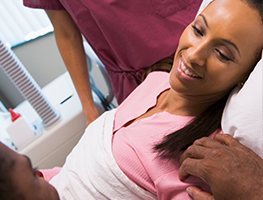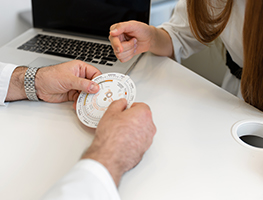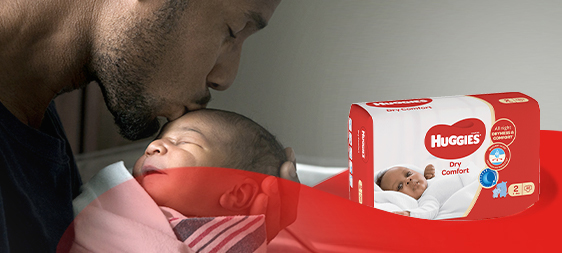If you and your partner are both under 35 and have no known health problems related to fertility, most medical professionals will suggest that you try to conceive for twelve months on your own before you even consider fertility treatment.
If you and/ or your partner are over 35, it is recommended that you seek help if you have not conceived after six months of unprotected sex.
If you do need to undergo fertility treatment, you may be in it for the long haul; it can take months or years to determine a cause or appropriate treatment, which is why older couples are advised to start fertility investigations earlier.
Though the chance in any one month for a healthy young couple to get pregnant following unprotected sex is only around 20 to 25%, around 90% of women will fall pregnant within 18 months of having regular intercourse near the time they ovulate.
If you’ve been trying for a while and things just don’t seem to be happening, it’s time to see your GP or gynaecologist and talk about your options – although there are usually a few steps before fertility treatment is recommended.
Usually, your doctor will first take a full medical history and do a basic physical examination before beginning some tests. (It will help if you have charted your ovulation cycle in recent months.)
There is a proven, medical cause behind an estimated 80% of couples with infertility – and many common, treatable conditions will actually lead to short-term infertility.
If you are experiencing a fertility problem, you’re not alone – this affects a number of couples of reproductive age.
Fertility specialist referral
After some initial tests, your GP may refer you and your partner to a fertility specialist. If you are on medical aid, first find out what they will and won’t cover. It is best to find a fertility specialist with training in Reproductive Endocrinology and Infertility – this means that the specialist may be more up-to-date with the latest investigations and treatments.
Before going through Fertility Treatment
Making the decision to seek diagnosis and treatment seems like an obvious one when you have been trying to fall pregnant for a year and the need to just ‘get on with it’ can seem overwhelming.
It is wise to seek some support and perhaps counselling in the early stages of fertility treatment. Many couples report that fertility treatment can be a very emotional and isolating experience, however it is a common one and there is often plenty of support available from others in the same situation, who have a good understanding of the experience.
Common Fertility Treatment Options, Assisted Reproductive Techniques (ART)
While the causes for infertility can vary widely among one or both partners, there are a fairly standard set of methods that can overcome many of these physical causes. Usually, the less invasive methods will be attempted first and then, if these are not helpful, methods such as IVF which involve far more intervention are a fall-back.
It’s important to understand from the very beginning that there can never be any guarantee with fertility treatments and you need to assess the emotional and physical cost of proceeding – or not proceeding – as well as the financial cost.
Success rates for different types of fertility treatment vary greatly. The most significant influencing factors include the age of the female partner and the reason behind the infertility.
Fertility Treatment: Assisted insemination
Reason for use:
Assisted insemination (also known as artificial insemination or intra-uterine insemination) is a fertility treatment used when there are issues with sperm quality (e.g. low motility or high levels of abnormal sperm) or quantity (low sperm count). It can also be used when the cervical mucous of the female partner has sperm antibodies.
What happens:
During the female partner’s fertile period, a semen sample is collected from the male partner and may be “washed” (treated in the laboratory to improve sperm) then injected through the vagina directly into the uterus through a silicon tube.
Fertility Treatment: Ovulation induction
Reason for use:
If a woman’s ovulation does not appear to occur naturally, or if ovulation is very irregular. This is linked to various conditions including polycystic ovary syndrome, pituitary gland malfunction sometimes caused by benign pituitary tumours, early menopause, or a history of excessive exercise and under nutrition.
What happens:
The female partner receives a series of hormones to stimulate egg growth and ovulation. If ovulation results, natural conception is often possible.
Some typical drugs used are:
-
Clomiphene citrate (e.g. Clomid), taken as a pill, which acts on the hypothalamus (in the brain) to prompt the pituitary gland to release the hormones LH and FSH, thus stimulating the ovaries to produce eggs.
-
Pulsed Gonadotropins, taken via a small pump which ‘pulses’ the drug into your bloodstream. The treatment consists of synthetic FSH and purified hCG hormones, which mimic the pituitary gland’s release of hormones.
-
Injected Gonadotropins, given as an intra-muscular injection, which stimulate the ovaries directly to produce eggs.
Fertility Treatment: IVF (In vitro fertilisation)
Reason for use:
A range of conditions are treated by IVF, including physical blockages in the fallopian tubes, issues with sperm quality or quantity and endometriosis. It is sometimes used also to treat unexplained infertility (which accounts for around 20% of cases).
What happens:
IVF is quite an invasive and long-running fertility treatment. The female partner receives a series of hormone injections to stimulate egg development. Then the eggs are extracted from the ovary by a thin needle. There are two main methods – either the needle is inserted through the vagina into the ovary and a local anaesthetic is used or the egg is extracted via laparascopy, involving an abdominal incision which may be performed under general anaesthetic. The egg is combined in a petri dish with her partner’s treated sperm. After several days of growing in the laboratory, the fertilised egg (zygote) is then placed into the uterus.
Fertility Treatment: GIFT (Gamete intra-fallopian transfer)
Reason for use:
The conditions treated by GIFT include endometriosis, cervical disorders, and some types of male infertility, however it is not suitable if there are problems in the fallopian tubes.
What happens:
The GIFT fertility treatment is similar to IVF, except when the egg and sperm are collected, they are mixed together and immediately injected back into the fallopian tube for fertilisation to occur.
Fertility Treatment: ZIFT (Zygote intra-fallopian transfer)
Reason for use:
Generally used for endometriosis and cervical disorders when there is no problem with sperm count or morphology and no fallopian tube issues.
What happens:
The ZIFT fertility treatment is similar to IVF, except the fertilised egg is placed directly into the fallopian tube rather than the womb. Because the fertilised egg is transferred directly into the tubes, the procedure is also referred to as tubal embryo transfer (TET). This procedure can be more successful than gamete intra-fallopian transfer (GIFT) because there is a greater chance of the egg being fertilised.
Fertility Treatment: ICSI (Intra-cytoplasmic sperm injection)Reason for use:
This is one of the most successful fertility treatments for male infertility and is used in cases where the male partner has a very low sperm count, produces few good-quality sperm, has problems with sperm motility or has a problem with anti-sperm antibodies in his semen. This fertility treatment is frequently used in cases of irreversible vasectomy or male tube blockages.
What happens:
The ICSI fertility treatment is used as part of an IVF fertility treatment, with one sperm injected directly into the egg.
Fertility Treatment: Epididymal and testicular sperm extraction
Reason for use:
This fertility treatment can help men who have a very low sperm count or abnormalities or blockages in their spermatic cord. It is also used for men who are unable to ejaculate, sometimes due to paraplegia or other physical disabilities.
What happens:
Using a needle, sperm are removed from the epididymis or directly from the testis and then used in IVF or similar fertility treatments or procedures.
Fertility Treatment: Donor eggs, embryos and sperm
Reason for use:
If a woman is over forty or has ovarian failure due to cancer treatments or other causes, or a man does not produce sperm, donor eggs or sperm or even donor embryos may be an option.
What happens:
Donor eggs, sperm or embryos are generally used with other Assisted Reproduction Techniques. Sperm donors in South Africa remain anonymous and their identities are legally protected, but the available donor profiles include information like age, physical characteristics, ethnic background, educational background, occupation, health, hobbies and interests.
All donors undergo a screening process that involves blood tests for diseases like HIV and other STDs. The semen is also analysed to ensure that the sperm is viable for donation.
Egg donation in SA is anonymous, confidential, legal and a regular routine procedure that involves no surgery or cutting. Egg donors must be between 21 and 33, of good health, must not have any STDs or HIV, and must not suffer from any mental illness or depression.

















